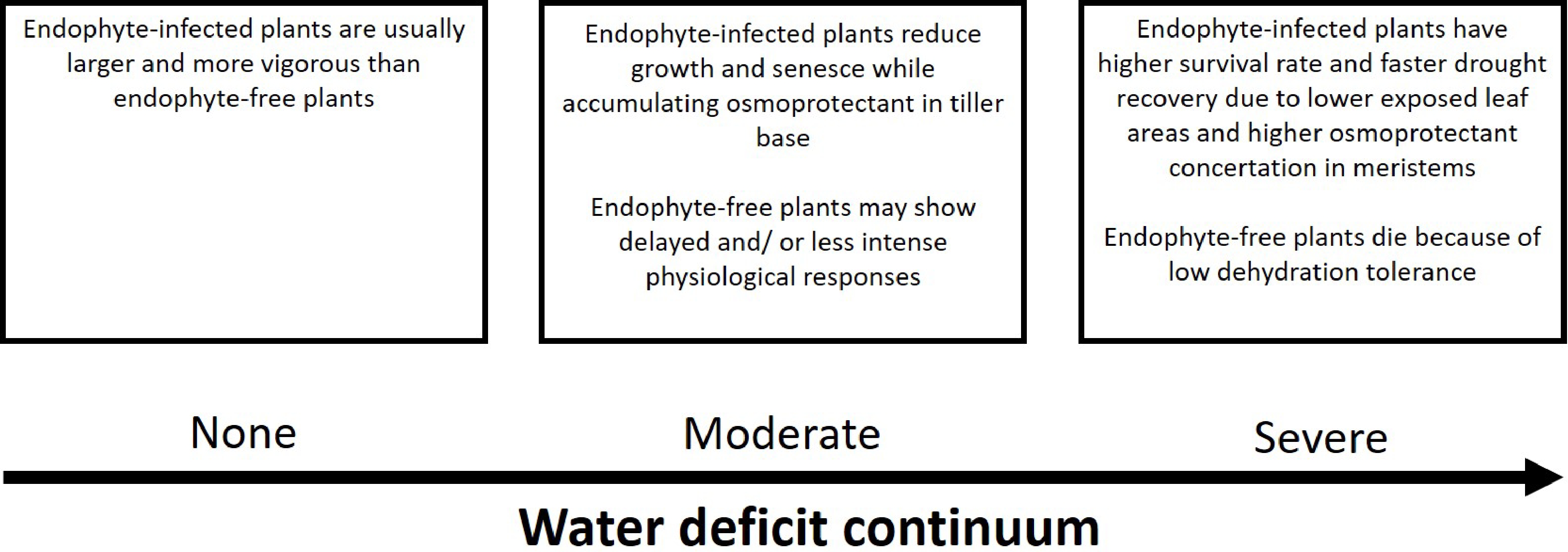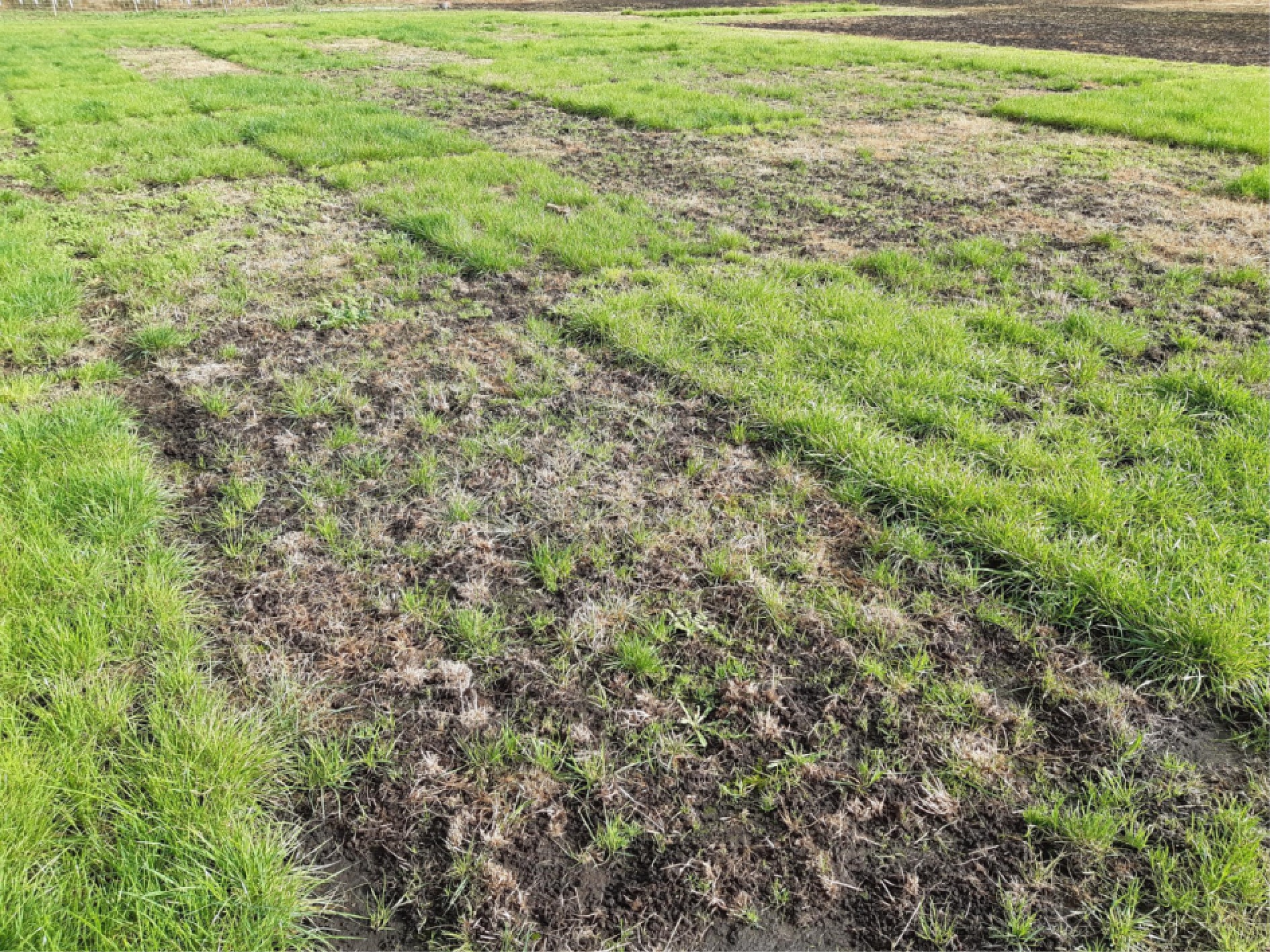-

Figure 1. A proposed schematic diagram of endophyte-infected and endophyte-free plant responses to increasing soil water deficit. Figure adapted from Assuero et al.[63].
-

Figure 2. Three-year-old perennial ryegrass trial in the Waikato, New Zealand. Plants in plots that have not survived were either endophyte-free or infected with an endophyte strain that did not protect the host plant against Argentine stem weevil or African black beetle during dry summers.
-
Insect Adult and larvae Argentine stem weevil (Listronotus bonariensis) Pasture mealybug (Balanococcus poae) African black beetle (Heteronychus arator) Root aphid (Aploneura
lentisci)Porina (Wiseana spp.) Grass grub (Costelytra zealandica) Black field cricket (Teleogryllus commodus) Animal health disorders Annual economic impact in a specific industry[20] Up to $\$ $ 200M dairy;$\$ $ 235M sheep & beefUnknown Up to $\$ $ 223M dairy;$\$ $ 19M sheep & beefUnknown Up to $\$ $ 84M dairy;$\$ $ 88M sheep & beef$\$ $ 275M−$\$ $ 706M dairy;$\$ $ 75M−$\$ $ 205M sheep & beefUnknown Diploid perennial ryegrass (E. festucae var. lolii)
AR1 Peramine ++++[21] ++++[22] +[23] −2[24] −[25] −[26] not tested none[10] AR37 Epoxy-janthitrems ++++1[27] ++++[22] +++[28] ++++[24] +++[25] +[26] not tested occasionally[29,30] NEA2 Peramine, ergovaline, lolitrem B +++[26] (++++)[26] +++[26] ++[24] not tested −[26] not tested none[26] NEA4 Peramine, ergovaline +++[26] (++++)[26] +++[26] ++[26] not tested not tested not tested none[26] Edge Peramine, ergovaline (++++)* (++++)* (+++)* (+++)* (−)* not tested not tested none* Avanex® Peramine, ergovaline, lolitrem B # # # # # # # # Diploid perennial ryegrass (E. siegelii) Happe Lolines (+++)* (++++)* (+++)* (++++)* (++++)* not tested not tested not tested Tetraploid perennial ryegrass (E. festucae var. lolii) AR1 Peramine (+++)[26] (++++)[26] +[26] −2[26] −[26] − not tested none AR37 Epoxy-janthitrems (+++)1[26] (++++)[26] +++[26] ++++[26] (+++)[26] + not tested occasionally[29,30] Italian and hybrid ryegrass (E. festucae var. lolii) AR1 Peramine ++[26] (++++)[26] +[26] −[26] not tested − not tested none NEA Peramine, ergovaline, lolitrem B Not tested (++++)[26] +++[26] not tested not tested − not tested none AR37 Epoxy-janthitrems +++1[26] (++++)[26] +++[26] not tested not tested − not tested occasionally[29,30] Festulolium (E. uncinata) U2 Lolines ++++[31] (++++)[32] ++++3[26] ++++[26] (++)[26] +++[33] +++[26] none Meadow fescue (E. uncinata)4 Tall fescue (E. coenophiala) MaxP/MaxQ Peramine, lolines (++++)[34] (++++)[32] ++++[26] (++++)[26] (++T)[35] +++R[35] ++++[36] none[36] Protek Lolines (++++)* (++++)* (++++)* (++++)* (++++)* (++++)* (++++)* none* − No protection.
+ Low level of control: Endophyte may provide a measurable effect, but is unlikely to give control in the field;
++ Moderate level of control: Endophyte may provide some protection in the field, with a low to moderate reduction of pest population.
+++ Good level of control: Endophyte significantly reduces insect damage under low to moderate insect pressure. Damage might occur during high insect pressure
++++ Very good control: Endophyte significantly reduces insect damage and pest population even under high pest pressure.
() Provisional rating: Testing is ongoing, further data is required to support rating.
1 AR37 only deters the more damaging ASW larvae not adult.
2 AR1 plants are more harmed than plants without endophyte.
3 Active against Black beetle adult and larvae.
4 A new meadow fescue cultivar infected with E. uncinata is now commercially available but has yet to be formally rated for its effects on insect pests. Previous work has shown that natural meadow fescue endophytes provide strong protection against a range of insect pests including black beetle, Argentine stem weevil and crickets[37−39]
* DLF Seeds & Science; ratings have not been approved by the New Zealand Plant Breeding & Research Association.
T - Higher plant growth compared with endophyte-free control but no difference in larval weight.
R - Reduced weight gain of grass grub larvae.
# - Toxic endophyte used at airports and sports fields to reduce the number of birds on or near sports fields and airfields[40].Table 1. Summary of Epichloë endophyte brands in ryegrass and fescue grasses available in New Zealand, Australia, and the USA: alkaloid profile, insect resistance properties, and livestock toxicity for each.
-
Species of grass and
endophyteImpact of endophyte Physiological and/or structural changes to host plant and endophyte in response to drought Reference Cultivated grasses Perennial ryegrass
(L. perenne)
E. festucae var. loliiIncreased tiller number and shoot weight 15% higher osmotic potential [64] Leaf water content not affected [65] Reduced leaf dehydration in moderately droughted plants [66] Variable effect related to original habitat of collection Increased root dry weight and root/shoot ratio [67] Lower dry weight, but less wilting Lower water use efficiency [68] In 4 of 6 Mediterranean populations endophyte improved drought tolerance Increased tiller number and yield [69] Beneficial for combined stresses of drought and Bipolaris sorokiniana Increased growth, and photosynthetic parameter, but decreased proline content [70] Provides physiological protection against drought Drought increased ergovaline and lolitrem B levels but endophyte had no effect on proline levels improved water use efficiency, relative water content and osmotic potential [71] No effect No effect on osmotic potential [72] No effect on stomatal conductance [62,73,74] No involvement to withstand or recover from drought [75−78] Higher seedling survival when released from drought No effect on reactive oxygen species [79] Tall fescue
(F. arundinacea)
E. coenophialaEndophyte responses vary with genotype Pseudostem, root and dead leaf yield increased with endophyte in some cases; no effect on non-structural carbohydrates [80] No consistent endophyte effect on dry weight per tiller, stomatal conductance; endophyte reduced leaf rolling in drought, but increased water content and delayed desiccation [81] No effect on leaf osmotic potential and minimal effect on plant water-soluble mineral and sugar concentrations [82] Improved plant survival under severe soil moisture deficit Leaf rolling under drought stress greater for endophytic plants; regrowth greater for endophytic plants when re-watered [83] Increased alkaloid levels [80,84,85] Increased soluble carbohydrates in leaves [63,86,87] Shedding of older leaves and rolling of younger leaves; low stomatal conductance; increased cellular turgor pressure [63,88] No effect on leaf rolling [89] Enhanced tiller density and plant survival [90] Maintained water use efficiency and photosynthetic rate better under drought [91] Enhanced osmotic adjustment in meristem; reduced stomatal conductance and transpiration [92,93] Reduced stomatal conductance; maintained higher water content of tiller bases [93] Root nematode inhibition by endophyte enhances drought tolerance [90,94] Increased plant available water [95] Reduced reactive oxygen species [96] Improved recovery after drought Improved tiller and whole plant survival [62,87,90,97−99] Improved root growth [100] Meadow fescue
(F. pratensis)
E. uncinatumImproved growth in drought Reduced stomatal conductance [101,102] Increased water uptake capacity [103] Production of larger but fewer tillers [104] Strong creeping red fescue
(F. rubra ssp. rubra) –
turf type E. festucaeNo improvement under drought [105] Native grasses Drunken horse grass
(Achnatherum inebrians)
E. gansuenseImproved tolerance to drought and recovery from drought Increased leaf proline, root/leaf growth, tiller number [106] Improved photosynthetic efficiency and nutrient absorption [107] Increased ergovaline and ergine alkaloid concentrations [108] Reduced disease incidence of Blumeria graminis [109] Achnatherum sibiricum
Epichloë spp.Endophyte benefit greatest when well-watered and fertilised Higher root: shoot ratio and photosynthetic rate under drought and fertiliation [110] Hordelymus europaeus
E. hordelymiImproved recovery from drought Increased tiller number and plant dry weight [111] Grove bluegrass
(Poa alsodes)
Epichloë spp.Improved the negative effects of drought stress Endophytic plants under drought had 24% more root biomass, 14% more shoot biomass; 29% more leaf senescence in non-endophytic plants [112] Arizona fescue
(Festuca arizonica)
Epichloë spp.Endophyte infection beneficial in drought Increased growth rates; low net photosynthesis and stomatal conductance [113] Bromus auleticus
E. pampeanum and
E. tembladeraeImproved survival in summer Higher regrowth rate [114] Roegneria kamoji
E. sinicaImproved seedling establishment in drought Improved germination and seedling growth [115] Elymus dahuricus
Epichloë spp.Improved yield and tiller numbers under drought Endophyte caused anti-oxidative enzyme activities and contents of proline and chlorophyll a + b increased under drought [116] Increased germination at moderate osmotic potentials [117] Elymus virginicus
E. elymiImproved drought tolerance, but also benefited well-watered plants No effect on root: shoot ratio; improved tiller number [118] Leymus chinensis
E. bromicolaImproved yield under drought Increased photosynthetic rate [119] Festuca sinensis
Epichloë spp.Endophytes enhanced drought tolerance Increased yield, root: shoot ratio [120] Table 2. The impact of Epichloë endophyte on the drought tolerance of a range of cultivated and native temperate grasses.
-
Endophyte type and trial protocol Known alkaloid expression Insect pest Drought effect Reference Ryegrass Italian ryegrass
(L. multiflorum)
E. occultans (presumably)
Pot trial in a glasshouseLolines and peramine Grass aphid
(Sipha maydis)
Cherry-oat aphid (Rhopalosiphum padi)Endophyte reduced aphid numbers but only on drought stressed plants. Aphid herbivory detrimental to endophyte infected well-watered plants.
Interactions between drought and aphids affected reproductive tillering in endophyte-free plants only.[138] Perennial ryegrass
(L. perenne)
E. festucae var. lolii
Field trial; visual assessment of larval damage scoredDependent on endophyte strain: ergovaline, peramine, lolitrem B Black beetle (Heteronychus arator) Summer/early autumn drought plus differences in black beetle root damage decreased plant survival and growth of susceptible plant-endophyte combinations compared with a resistant one. [139] Perennial ryegrass
(L. perenne)
E. festucae var. lolii
Field trialDependent on endophyte strain: ergovaline, peramine, lolitrem B, epoxy-janthirems Root aphid (Aploneura lentisci)
Field measurements of population densities and ryegrass growthDrought may have increased aphid populations and likely exacerbated their effect on plant growth. Two endophytes strongly reduced populations. Aphid populations correlated with plant growth. [140] Fescue Tall fescue
(F. arundinacea)
E. coenophiala
Pot trial in a glasshouseN-acetyl and N-formyl lolines Number of cherry-oat aphids (Rhopalosiphum padi) Aphid density reduced by endophyte, and by drought stress in endophyte-free plants only. [141] Development time of fall armyworm (Spodoptera frugiperda) Growth and development reduced by endophyte-infected drought stressed herbage compared with well-watered. No effect on larvae fed Nil herbage. [141] Growth of fall armyworm (Spodoptera frugiperda) Tall fescue
(F. arundinacea)
E. coenophiala
AR584
Excised roots from treated plants feed to 3rd instar grass grubLolines Grass grub (Costelytra given) 3rd instar larvae Root consumption of endophyte-free plants higher if plants droughted compared with well-watered endophyte-free; larval weight change reduced by endophyte fed droughted plant roots. Loline concentration in roots higher in droughted than in well-watered plants. [142] Meadow fescue (F. pratensis)
E. uncinata
Excised roots fed to 3rd instar grass grubEndophyte reduced root consumption, frass output, and larval weight change; effects greatest for well-watered plants; loline concentration higher in roots of well-watered plants than droughted plants. [142] Red fescue
(F. rubra)
E. festucae
Field survey and common garden experimentErgovaline Locusts
Locusta migratoria)Endophyte significantly reduced weight and survival of locusts [143],
[144]Table 3. Impact of Epichloë on the interaction between drought and insect herbivory
Figures
(2)
Tables
(3)